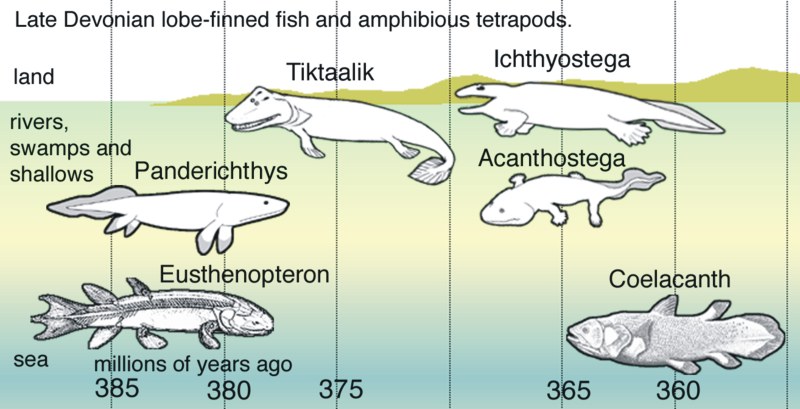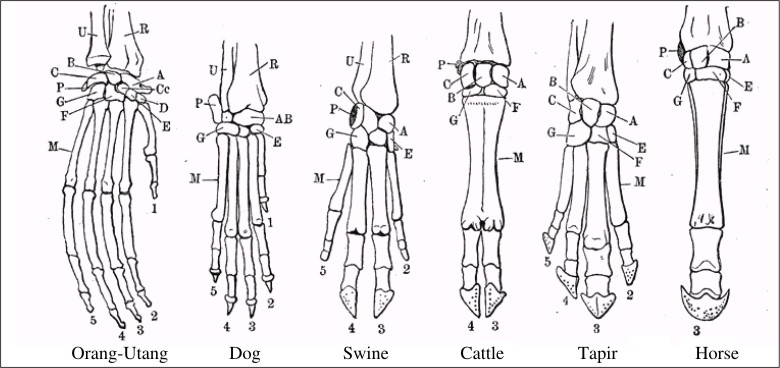In this newsletter:
1) Something fishy with fish fingers
2) The bankruptcy of homology
3) Website pick: Physicians and Surgeons for Scientific Enquiry
4) Niagara Falls creation tour
5) Answer to the last contest question
***********************************************************
1) Something fishy with fish fingers
(The first two sections of this newsletter are posted in the science notes on my website)
Just this past week, an article came out in Nature magazine relating to Panderichthys, a supposed “fishopod.” Bear with me – this is going to be confusing, but that’s not my fault!
If you recall, the evolutionary myth has fish evolving legs and walking up on land, becoming tetrapods (land walkers). Hence the nickname “fishopod” – it’s half-fish, half-tetrapod…. or so certain evolutionists would have you believe.
| This week’s ruckus arises from a CT scan of the front fin of a Panderichthys fossil, seen on the right. (To familliarize yourself with CT scans, see the video on the Delk track: https://ianjuby.org/delk) The purple bone at the top is the bone that anchors to the body, and the little brown bones at the tip are what’s causing all the fuss. You see, previously, it was thought that the bones at the end of the fin (the two blue, the yellow, and five brown bones) were only two bones. It turns out there was actually six of them (as revealed by the CT scans), and the four small dark brown bones may be “four radials that hint at the future development of fingers.” (as suggested in the CBC report here.) |
 photo: C. Boisvert and P. Ahlberg |
To see just how clear the mud is, we need to first take a crash course in fishopod evolution – work with me here!
Wikipedia nicely spells it out for us, in graphic form:

You can see the implied “evolutionary ascent” from fish to fishopod over time. Seeing as how all the fuss is over a fin, I’m going to focus just on the fins, timeline, and supposed evolution.
Let’s first ask the question “Why do they think these fossils show an evolutionary sequence?” The implied answer of course, is that these fossils show improvement and change from fish to tetrapod over time. But even just looking at the fins, the whole story just turns into another fish story real quick! While I don’t believe in these millions of years, and I don’t believe in these “radial bones,” I’m going to meet the evolutionary myth where it’s at and examine the interpretations. I’ll use a chart from Nature so you can see the “evidence” and claims yourself.:

Graphic from Nature magazine.
Eusthenopteron first appears 385 million years ago. It has five radial bones.
Panderichthys, first appearing 380 million years ago, is now believed to have four radial bones.
The Canadian fishopod, Tiktaalik, was found in 375 million year old rock. It’s not known how many radial bones it has, because some of the fossil was missing, but it probably had eight. What’s important here though is that Tiktaalik has a complex ‘wrist joint,” which was claimed to help it walk on land.
Ichthyostega has been found in rocks “dated” at 367 to 362.5 million years old. Because the front flipper/foot was not found, it is not known how many radial bones (if any) it may have had, nor if it had a wrist – however,
Acanthostega, supposedly 365 million years old, did not have a wrist, and had eight radial bones.
So if we were to follow this “fossil sequence,” it would appear that the evolution of the finger has been a wild ride:
First we evolved five fingers, then in our evolutionary ascent we lost two, then gained four back at Acanthostega. Once on land, the number went back down to four (most amphibians have four toes). Apparently we evolved a complex wrist, only to lose it again at Acanthostega, and then apparently re-evolve it back once the critters got onto land.
 In the meantime, what is not shown accurately on the wikipedia timeline above is that the Coelacanth is actually the oldest known creature on that chart! The oldest Coelacanth known is from Australia and dated at over 410 million years old. Although only a jawbone has been found, presumably it’s at least similar to the other Coelacanths we do know of, which have lots of “radial bones” in its fin!
In the meantime, what is not shown accurately on the wikipedia timeline above is that the Coelacanth is actually the oldest known creature on that chart! The oldest Coelacanth known is from Australia and dated at over 410 million years old. Although only a jawbone has been found, presumably it’s at least similar to the other Coelacanths we do know of, which have lots of “radial bones” in its fin!
The Coelacanth has evolved over hundreds of millions of years into… Coelacanths.
So during all this time of Eusthenopteron evolving into Panderichthys, evolving into Tiktaalik, which was supposedly evolving into Ichthyostega and Acanthostega, the Coelacanth remained unchanged and has remained unchanged to this day.
The Coelacanth makes a marvelous study, because before it was found alive, evolutionists were saying the exact same things about it that they are now claiming about Ichthyostega, Tiktaalik, Acanthostega, etc….
In fact, you can still see this bias in modern day reports and websites. For instance,
(From I.O.L. Science)
Are these interpretations based on observation? No – because the Coelacanth lives in very deep water, and does not use its fins for anything other than swimming. So what’s this nonsense in the I.O.L. article about excursions onto land? There is no connection – simply evolutionary assumption.
We can observe the Coelacanth behaviour. We can not observe the behaviour of Acanthostega, Ichthyostega, Panderichthys and others because they are not known to be alive now. Therefore, all this talk of using their fins to walk on land is nothing more than wild speculation, the same wild speculation they hurled upon the Coelacanth, which turned out to be false. The evolution of fish to tetrapods is also nothing more than wild speculation.
All of this talk of fish makes me hungry, so I’m going to go fry up some Captain Highliner and some chips. These arguements are arguments from Homology….
***********************************************************
2) The bankruptcy of homology
Homology is a comparitive similarity between two organisms. For example, in this incredibly complex-looking drawing:

the bones in the limbs of various animals can be similar in position, structure, etc…
This is a common argument used to promote evolution, as it could be interpreted that these animals all have similar limbs because they evolved from a common ancestor. Thus, they all inherited traits from this one ancestor they all had in common.
It sounds impressive at first, but there a few problems with this interpretation. Bear with me while I get a little technical on ya:
With the fairly new science of genetics, we can now map out what genes hold the blueprints for various parts of our bodies. As a result, we now know that while the bones between two animals may appear to be homologous, the blueprints for these bones come from completely different parts of the genome! Therefore similarity between two organisms is not because of a common ancestor, otherwise, they would also share similar, homologous traits in their genome as well. They do not.
 The similarity between the organisms apparently has nothing to do with a common ancestor, but rather a common designer. One can see a lot of similarities between the early Volkswagens and early Porsches. Is this because they evolved from a common ancestor? No, it’s because they both had a common designer – Ferdinand Porsche.
The similarity between the organisms apparently has nothing to do with a common ancestor, but rather a common designer. One can see a lot of similarities between the early Volkswagens and early Porsches. Is this because they evolved from a common ancestor? No, it’s because they both had a common designer – Ferdinand Porsche.
Homology is only cited when it appears to support evolution. Simultaneously, the lack of homology is ignored when it poses a problem for evolution. For example, a great many evolutionists (and National Geographic) believe that dinosaurs evolved into birds.
Many dinosaurs fall into two classes, based on their hip structure.
The Ornithischians are named after their ‘bird-like hips.’ ‘Orni’ is from the Greek word ornitheos, for ‘of a bird,’ and ‘ischion’ for ‘hip joint.’
The Saurischians include bipedal dinosaurs like T. rex and the Sauropods. They are called this because they have hips like lizards and ‘Saurus’ is the Greek word for ‘lizard.’
So put yourself in the shoes of an evolutionist who believes that birds evolved from dinosaurs. Which group would you assume that the birds evolved from? The Ornithischians? Some of the Ornithischian dinosaurs have bird-like feet, some have bird-like beaks, and they all have bird-like hips.
Or would you assume it was the Saurischians? Some of the Saurischian dinosaurs have elephant-like feet, some have bird-like feet, but no other real similarities to birds. They all have lizard-like hips.
If homology were actually an argument for evolution, the answer would be obvious – it would have to be the Ornithischians. However, the dino-to-bird theorists actually believe it was the Saurischians that evolved into birds!
Clearly homology is not evidence for the evolutionary myth.
***********************************************************
3) Website pick: Physicians and Surgeons for Scientific Inquiry
I was recently forwarded the link to the PSSI website, and shortly thereafter, the CEO of PSSI happened to drop me an email. I had encountered PSSI once before, via Dr. Joseph Kezele (http://www.azosa.org/Professionals.aspx), who is the president of The Arizona Origins Science Association, AzoSA (http://www.azosa.org/). I’ve spoken there a few times and Dr. Kezele and his team are an impressive and active group.
The blog on the PSSI website has not been kept up to date since the membership list was published last year, however the comments are still pertinent. They reflect quite nicely what I was trying to say in the last newsletter, and I’d encourage readers to go check it out:
http://www.pssiinternational.com
***********************************************************
4) Niagara Falls creation tour
Coming up in a few short weeks, Josiah Detwiler (director of the Akron Fossils and Science Center) will be organizing a creation interpretation tour of the Niagara Falls and Niagara gorge on Sunday, October 5th. The following day we will be meeting Canadian side and studying and touring there as well, and anyone is welcome to join us on that day as well. I’m speaking in Madoc, Ontario on the 5th, so I won’t get there till Monday morning. The information is here, please contact Josiah directly for itinerary, and to let him know you’re interested.
Dear Friends,
I have exciting news for you. I recently met a Christian man who is a creationist geology guide in Niagara Falls! I have scheduled a group tour with Terry Kanouse (the guide) on Sunday, October 5th from 3-7 PM on the American side of Niagara Falls in Buffalo, New York. And I am extending an invitation for you and your family to join me on this trip.
The guided tour will take place on the rim of the Niagara Gorge along the public viewing overlooks and walkways. The tour will be well suited for both children and adults. Terry Kanouse, was a guide for a tourist company at Niagara Falls for about a decade. Terry was fired from his job when it became known that he did not believe in the standard millions of years timescale for the formation of Niagara Falls.
Free Group Tour
The group tour is free with the exception of a $12.50 per person fee to ride the Maid of the Mist. Even though Terry is guiding the group tour free of charge, I’d encourage everyone that comes to consider giving Terry some kind of financial gift, as able. Terry takes special time off from his busy job as a security guard to give these guided tours and I’d like to be able to bless Terry and encourage him in his ministry.
Please Reply ASAP
I apologize for the short notice about this field trip but I did not have all of the details for the trip arranged until just recently.
If you are interested in coming on this trip I need to hear back from no later than a week from today (Wednesday, October 1st, 2008).
To learn more, please call or email me at my personal email address *****@********.org or phone (330) 958-2715
Sincerely,
Josiah Detwiler
***********************************************************
 In the last newsletter, you were challenged to come up with the correct date of the dedication of the Cambodian temple of Ta Prohm. Congratulations to those who won.
In the last newsletter, you were challenged to come up with the correct date of the dedication of the Cambodian temple of Ta Prohm. Congratulations to those who won.
The year of dedication was 1186 A.D.
Don Patton and Dennis Swift were the first to bring the stegasaurus carving to the attention of the creation community, this is one of his pictures.
Head on over to Don Patton’s website report on this find, and ask yourself the question:
“How did they know what a stegasaurus looked like in 1186 A.D., when the first stegasaurus was discovered in 1876?”




The mystery of ancestral descent
This is tale which tells what recessive genes hold, what inbreeding cause’s and what degenerate animals look like.
A male lion breeds with a female tiger, makes a liger of great size!
2
a male leopard breed with a female lion brings forth a leopon. Which not only has the size and strength of the lion but also has the climbing abilities of the leopard.
3
All that has so far been said, is recognized by science.
4
Now into the realm of what has not yet been ‘validated’ (by science).
5
All the other cats are said to interbreed
from time to time.
6
The division of Species is based on the idea that, only members of the same ‘Species’ can indeed breed.
But if all cats ( including the Egyptian house cat) can breed, they are not different Species but only subspecies of the original cat.
Now, if the liger is bigger and the leopon is of the same size and better. Then it comes to reason that the original cat from off the Ark was a super cat.
Scientists say that the “extra” abilities that come out of these ‘hybrids’ are caused by “recessive genes”
Recessive Genes are created by inbreeding.
Now here is the part that might interest a historian.
Gen 7:2
“Of every clean beast thou shalt take to thee by sevens, the male and his female: and of beasts that are not clean by two, the male and his female.”
In this I think that the clean animals were allowed to descend without inbreeding and therefore pure. While the others were forced into inbreeding, which caused their abilities to go into ‘Recessive genes’. The ancients had enough trouble with the lions, tigers, etc. So this might have been set to preserve man. Did you know that in India they breed the wild dog with the wolf to get a bigger breed. This alone means nothing, except that there is a story whcih appeared shortly after the flood. No later that 500 years, or 600, or 700, etc, after the flood. The story told of a great king who had wolves so great that his men were able to ride upon them, for they were far greater than any horse.
Maybe I’m going nowhere, but if only two cats, two dogs, two bears, etc, walked off the Ark. Then I say that it would immediately force inbreeding, which in turn would force abilities to go into recessive genes. And (to the point) would force the super Cat to degenerate into the lion, tiger, leopard, cheetah and house cat that we have today.
I’m sorry I couldn’t help joking and calling the lion and tiger a degenerate.
“In the production of pure breeds of sheep, cattle, hogs, and horses inbreeding has frequently been practiced extensively, and where in such cases selection has been made of the more vigorous offspring as parents, it is doubtful whether any diminution in size, vigor, or fertility has resulted. Nevertheless it very frequently happens that when two pure breeds are crossed, the offspring surpass either pure race in size and vigor.”
Sudden Origins by Jeffrey H. Schwartz
The tiger is either a pure breed are a degenerate species!
Or I say.
They are one and the same..!!!!!!!!!!!!!!!!!!!!!!!!!!!!!!!!!!!!
Else, the reason why the clean were in sevens as opposed to the others.
Genetic research (and this basic reasoning and breeding) has shown that every type of wolf, dog, fox and coyote etc. came from the 1 original wolf.
Scott, John Paul and John L. Fuller Genetics and the Social Behavior of the Dog
Behaviour of Wolves, Dogs and Related Canines (Hardcover) by Michael W. Fox
Mitochondrial Eve (mt-mrca)
“Mitochondrial Eve is the ………..common ancestor (MRCA) of all human via the mitochondrial DNA pathway . In other words, she is the MRCA found when ancestry of all living humans is traced back in time, following only the maternal lineage. Mitochondrial DNA pathway is equivalent to maternal lineage, because Mitochondrial DNA is only passed down from mother to child, never father to child. [1]”
Camel-Llama-alpaca
All known subspecies of the “horse” are known to breed!
1 Last thing.
this theory is observable & testable, in that you can breed new ‘breeds’ of dogs in just a few years. But each of these will have less ‘ablities’ than the last.
Just take 2 dogs (of your choice) & place them in a zoo. Now there children will be fine but as there children breed with each other you will see the same thing happen. Only it will go ten times further than before.
Kentish Son
I am sending this into the world because I want to get the word out.